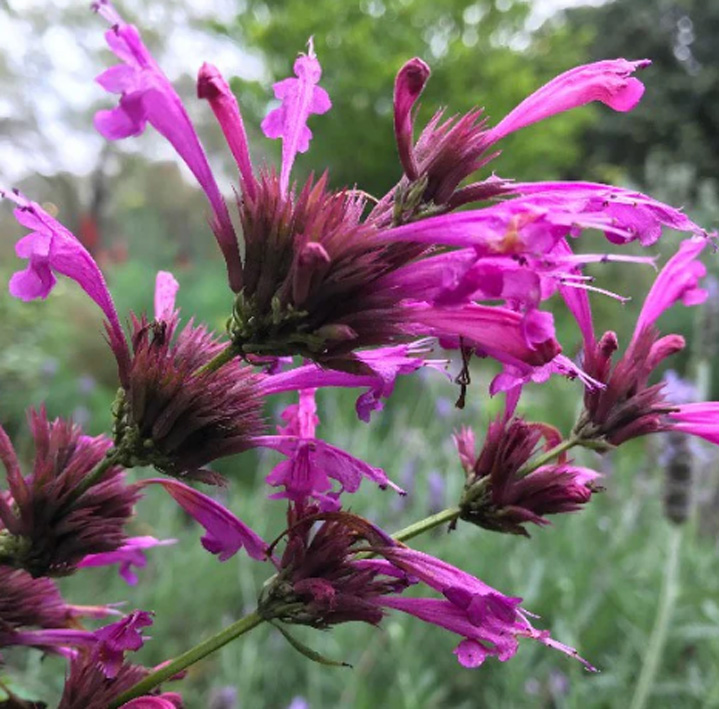Rescue and conservation of traditional knowledge on medicinal plants in the Sierra de Taxco, Guerrero, Mexico: The case of Toronjil (Agastache mexicana subsp. mexicana)
DOI:
https://doi.org/10.18387/polibotanica.60.25Keywords:
Medicinal plants, Ethnobotany, Sustainable management, PreservationAbstract
The objective of this study was to investigate and document traditional knowledge on the use of medicinal plants, with emphasis on the uses and properties of lemon balm (Agastache mexicana subsp. mexicana) in three localities in the mountains of the municipality of Taxco de Alarcón, Guerrero, Mexico, contributing to the rescue and conservation of ancestral knowledge. The hypothesis was that, in the three localities studied, there is extensive traditional knowledge on the use of lemon balm (Agastache mexicana subsp. mexicana) and other medicinal plants, mainly for the treatment of common health problems. To obtain information, semi-structured interviews were conducted with people over 18 years of age and the ꭓ² test (chi square) was applied to analyze the relationships between the variables. The results identified 52 species of medicinal plants grouped into 26 botanical families. The most prominent family is Lamiaceae (12 species), followed by Asteraceae (7 species). People mention that they use medicinal plants mainly for gastrointestinal problems (39%); secondly, for respiratory and musculoskeletal problems (17%). The plants used come mainly from the wild (56%) and to a lesser extent (44%) are cultivated. Regarding Agastache mexicana subsp. mexicana, all three localities know, consume and have it at home. Its main uses are to counteract: stomach pain and/or colic, respiratory problems, nerves and finally problems of cultural affiliation known as susto. The way of consuming medicinal plants is through decoction using mainly the leaves. In addition, 90% of those interviewed showed interest in preserving medicinal plants by cultivating them in family gardens, promoting sustainable management to avoid the decline of species.
References
Akram, M., Riaz, M., Noreen, S., Shariati, M. A., Shaheen, G., Akhter, N., Parveen, F., Akhtar, N., Zafar, S., Owais Ghauri, A., Riaz, Z., Khan, F. S., Kausar, S., & Zainab, R. (2020). Therapeutic potential of medicinal plants for the management of scabies. In Dermatologic Therapy (Vol. 33, Issue 1). John Wiley and Sons Inc. https://doi.org/10.1111/dth.13186
Angulo, A. F., Rosero, R. A., & González Insuasti, M. S. (2012). Estudio etnobotánico de las plantas medicinales utilizadas por los habitantes del corregimiento de Genoy, Municipio de Pasto, Colombia. Universidad y Salud, Vol. 14(2), 168–185. http://www.scielo.org.co/pdf/reus/v14n2/v14n2a07.pdf
Ávila-Uribe, M. M., García-Zárate, S. N., Sepúlveda-Barrera, A. S., & Godínez-Rodríguez, M. A. (2016). Plantas medicinales en dos poblados del municipio de San Martín de las Pirámides, Estado de México. Polibotánica, 42, 215–245. https://doi.org/10.18387/polibotanica.42.11
Bermúdez, A., Oliveira, M., & Velázquez, D. (2005). La investigación etnobotánica sobre plantas medicinales: Una revisión de sus objetivos y enfoques actuales. Interciencia, 30(8), 453–459. https://ve.scielo.org/scielo.php?pid=S0378-18442005000800005%20&script=sci_arttext
Carrillo-Galván, G., Bye, R., Eguiarte, L. E., Cristians, S., Pérez-López, P., Vergara-Silva, F., & Luna-Cavazos, M. (2020). Domestication of aromatic medicinal plants in Mexico: Agastache (Lamiaceae)- A n ethnobotanical, morpho-physiological, and phytochemical analysis. Journal of Ethnobiology and Ethnomedicine, 16(1), 1–16. https://doi.org/10.1186/s13002-020-00368-2
CONEVAL. (2022). Consejo Nacional de Evaluación de la Política de Desarrollo Social. Medición de la pobreza. https://www.coneval.org.mx/Medicion/MP/Paginas/Pobreza_2022.aspx
De Blas, I. (2006). Sofware winEpi Facultad de Veterinaria (p.). http://www.winepi.net/
Estrada-Reyes, R., López-Rubalcava, C., Ferreyra-Cruz, O. A., Dorantes-Barrón, A. M., Heinze, G., Moreno Aguilar, J., & Martínez-Vázquez, M. (2014). Central nervous system effects and chemical composition of two subspecies of Agastache mexicana; An ethnomedicine of Mexico. Journal of Ethnopharmacology, 153(1), 98–110. https://doi.org/10.1016/j.jep.2013.12.057
Fernández-Cusimamani, E., Espinel-Jara, V., Gordillo-Alarcón, S., Castillo-Andrade, R., Žiarovská, J., Zepeda-Del Valle, J. M., & Lara-Reimers, E. A. (2019). Estudio etnobotánico de plantas medicinales utilizadas en tres cantones de la provincia Imbabura, Ecuador. Agrociencia, 53(5), 797–810. https://www.agrociencia-colpos.org/index.php/agrociencia/article/view/1844/1841
Gálvez, J., Estrada-Reyes, R., Benítez-King, G., Araujo, G., Orozco, S., Fernández-Mas, R., Almazán, S., & Calixto, E. (2015). Involvement of the GABAergic system in the neuroprotective and sedative effects of acacetin 7-O-glucoside in rodents. Restorative Neurology and Neuroscience, 33(5), 683–700. https://doi.org/10.3233/RNN-140486
García, E. (2004). Modificaciones al sistema de clasificación climática de Köppen. Universidad Nacional Autónoma de México. http://www.publicaciones.igg.unam.mx/index.php/ig/catalog/view/83/82/251-1
Gutiérrez-García, G., Espinosa-Ayala, E., Abel Hernández-García, P., Pavón-Silva, T. B., & Márquez-Molina, O. (2020). Conocimiento y práctica de la herbolaria en el estado de México, pautas hacia la sustentabilidad. Agrociencia, 54(8), 1043–1058. https://www.agrociencia-colpos.org/index.php/agrociencia/article/view/2301/2022
Hernández-Ramírez, U., Trujillo-Nájera, M., Romero-Rosales, T., Huicochea Moctezuma, A., Adame-Zambrano, T. de J., & Gruintal-Santos, M. A. (2022). Percepción local de los usos y situación ambiental y económica del toronjil (Lamiaceae) en tres comunidades del estado de Guerrero, México. Polibotánica, (54), 257–269. https://doi.org/10.18387/polibotanica.54.16
INEGI. (2020). Instituto Nacional de Estadística y Geografía. Censo de Población y Vivienda 2020. https://www.inegi.org.mx/programas/ccpv/2020/default.html#Datos_abiertos
Jiménez-González, A., Mora Zamora, K. J., Rosete Blandariz, S., & Cabrera Verdesoto, C. A. (2021). Utilización de plantas medicinales en cuatro localidades de la zona sur de Manabí, Ecuador. Siembra, 8(2). https://doi.org/10.29166/siembra.v8i2.3223
Lot, A., & Chiang, F. (1986). Manual de Herbario: Administración y manejo de colecciones, técnicas de recolección y preparación de ejemplares botánicos. Consejo Nacional de la Flora de México, A.C. México. 142 pp. https://issuu.com/jpintoz/docs/1986_lot-chiang_manualherbario_cnfm
Magaña-Alejandro, M. A., Gama-Campillo, L. M., & Mariaca-Méndez, R. (2010). El uso de las plantas medicinales en las comunidades Maya-Chontales de Nacajuca, Tabasco, México. Polibotánica, (29), 213–262. https://www.scielo.org.mx/pdf/polib/n29/n29a11.pdf
Martínez, M. (1998). La investigación cualitativa etnográfica en educación. Tercera edición. México: Trillas. (pp. 65–68). https://profeinfo.files.wordpress.com/2020/06/investigacion-cualitativa-etnografica-martinez.pdf
Parry, L., Radel, C., Adamo, S. B., Clark, N., Counterman, M., Flores-Yeffal, N., Pons, D., Romero-Lankao, P., & Vargo, J. (2019). The (in)visible health risks of climate change. In Social Science and Medicine (Vol. 241). https://doi.org/10.1016/j.socscimed.2019.112448
Reyes, R. S., Rojas, I., Arvizu, G., Muñoz, D., Peréz, D., & Sucilla, M. (2005). Caracterización del potencial fitotóxico de Agastache mexicana (kunth.) Lint et Epling. Investigación Universitaria Multidisciplinaria: Revista de Investigación de La Universidad Simón Bolívar, (4), 2.
Santillán-Ramírez, M. A., López-Villafranco, M. E., Aguilar-Rodríguez, S., & Aguilar-Contreras, A. (2008). Estudio etnobotánico, arquitectura foliar y anatomía vegetativa de Agastache mexicana ssp. mexicana y A. mexicana ssp. xolocotziana. Revista Mexicana de Biodiversidad, 79(2). https://www.scielo.org.mx/pdf/rmbiodiv/v79n2/v79n2a24.pdf
Sotelo-Leyva, C., Tagle-Emigdio, L. J., Aniceto-Teofilo, C., Galeana-Hernández, J., Condori-Cordero, S., Flores-Blanco, G., & Salinas-Sánchez, D. O. (2022). Estudio etnofarmacológico y fitoquímico de las plantas medicinales de mayor uso en Julián Blanco, Guerrero, México. Acta Agrícola y Pecuaria, 8(1). https://doi.org/10.30973/aap/2022.8.0081012
Thompson, E. (1992). Wiley Series en probabily and statistics. (Vol. 1).
UNAM. (2009). Universidad Nacional Autónoma de México. Biblioteca Digital de la Medicina Tradicional Mexicana. http://www.medicinatradicionalmexicana.unam.mx/
Valdés-Cobos, A. (2013). Conservación y uso de plantas medicinales el caso de la región de la Mixteca Alta Oaxaqueña, México. Ambiente y Desarrollo, 17(33), 87–97. file:///C:/Users/mgrui/Downloads/adminpujojs,+AyD+17-33+Art.+6%20(20).pdf
Zambrano-Intriago, L. F., Buenaño-Allauca, M. P., Mancera-Rodríguez, N. J., & Jiménez-Romero, E. (2015). Estudio etnobotánico de plantas medicinales utilizadas por los habitantes del área rural de la Parroquia San Carlos, Quevedo, Ecuador. Universidad y Salud, 17(1), 97–111. http://www.scielo.org.co/pdf/reus/v17n1/v17n1a09.pdf
Zhang, Y., Long, Y., Yu, S., Li, D., Yang, M., Guan, Y., Zhang, D., Wan, J., Liu, S., Shi, A., Li, N., & Peng, W. (2021). Natural volatile oils derived from herbal medicines: A promising therapy way for treating depressive disorder. In Pharmacological Research (Vol. 164). https://doi.org/10.1016/j.phrs.2020.105376

Downloads
Published
License
Copyright (c) 2025 POLIBOTANICA

This work is licensed under a Creative Commons Attribution-NonCommercial-ShareAlike 4.0 International License.

Polibotánica by Departamento de Botánica de la Escuela Nacional de Ciencias Biológicas del Instituto Politécnico Nacional se distribuye bajo una Licencia Creative Commons Atribución-NoComercial-CompartirIgual 4.0 Internacional.



















